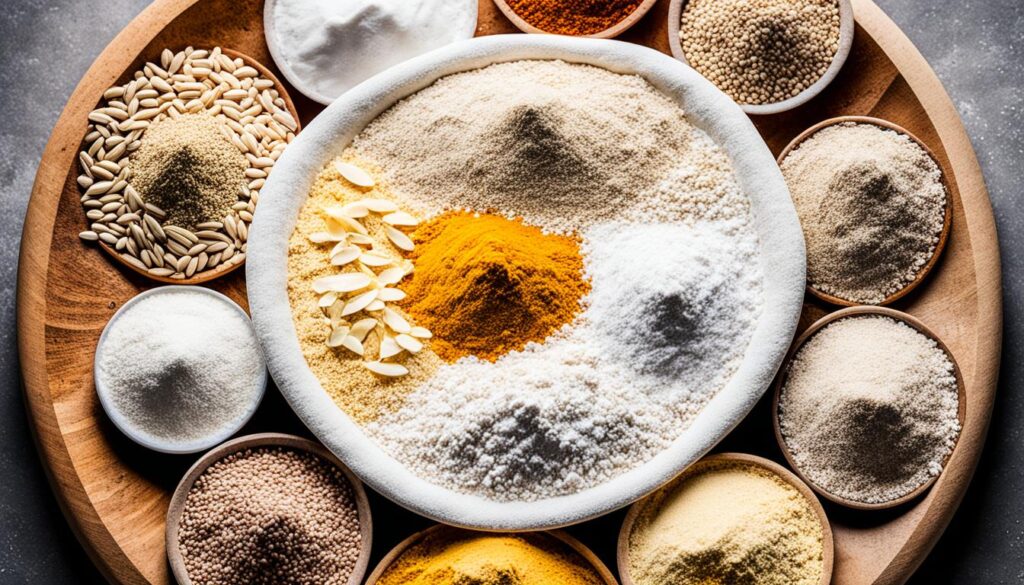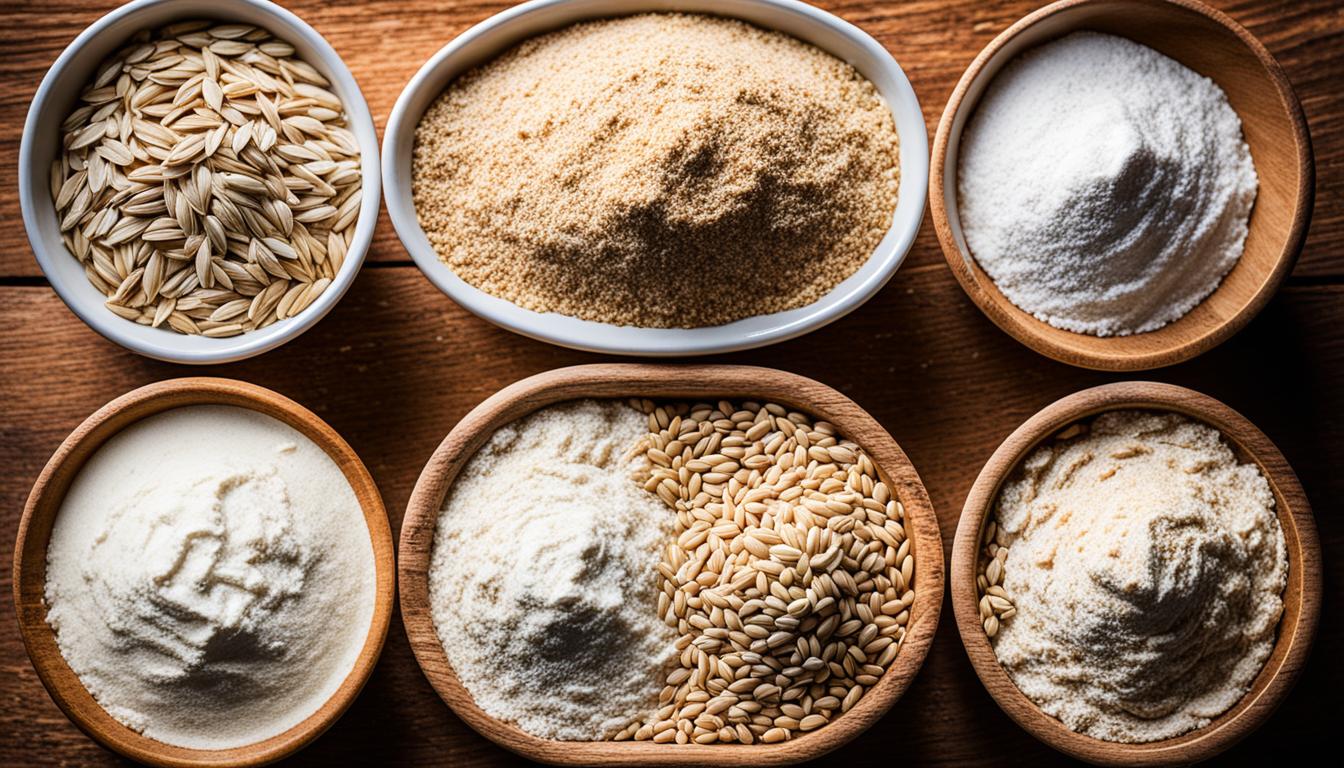Did you know that the type of flour you choose for your sourdough starter can have a significant impact on its development and performance? In fact, a study found that the wrong flour choice can lead to a sluggish or even failed starter, costing bakers valuable time and resources. That’s why we’re embarking on a comprehensive investigation to uncover the best flour for sourdough starters.
There are many variables at play when it comes to creating a successful sourdough starter, from the type of liquid used and hydration levels to fermenting temperatures. One of the first decisions a sourdough baker must make is what type of sourdough starter flour to use. This investigation aims to explore the different flour options and their effects on starter development and performance.
We’ll cover the most commonly used flours for sourdough starters, including unbleached all-purpose flour, unbleached bread flour, whole wheat flour, rye flour, and various flour blends. Key factors to consider when choosing the right flour for sourdough, such as hydration level and feeding ratio, will also be discussed. By the end of this comprehensive investigation, our readers will have a better understanding of the flour that will work best for their sourdough starter needs.
Types of Flour for Sourdough Starters
When it comes to creating a thriving sourdough starter, the type of flour you choose can make a significant difference. Let’s explore the various flour options and how they can impact the development and performance of your sourdough culture.
Unbleached All-Purpose Flour
Unbleached all-purpose flour, such as the renowned King Arthur brand, is a popular choice for sourdough starters. With a relatively high protein content of around 11.7%, this flour provides a suitable foundation for starter development without undergoing the bleaching process, which can deplete the potential microbe population in the flour.
Unbleached Bread Flour
Bread flour, with a protein content ranging from 12-14%, has a higher gluten potential than all-purpose flour. This greater gluten potential can help the starter withstand the expansion of carbon dioxide as it matures, trapping gas more easily. However, bread flour may have limited availability for the average consumer.
Whole Wheat Flour
Whole wheat flour includes the entire grain of wheat, including the bran, endosperm, and germ. This minimally processed flour is said to be packed with nutrients and potential microbes, providing faster fermentation for a starter. However, the inclusion of bran can inhibit gluten development, resulting in a dough that may not rise as high or retain its shape as effectively.
Rye Flour
Rye flour is another popular option for sourdough starters. Naturally rich in amylases, nutrients, and microbes, rye flour enables a starter to quickly convert sugars for faster, more efficient fermentation. Compared to whole wheat flour, rye flour is considered the most nutrient- and amylase-dense option for a sourdough starter. However, rye flour has a lower gluten protein content than wheat flour, which can result in slack, sticky, and dense doughs.
Flour Blends
Many bakers employ blends of flours to produce starters that match their preferences for activity and flavor. For example, some bakers use a blend of 90% bread flour and 10% rye flour, as the smaller amount of rye can provide a boost of activity without making the starter overly sour. Blending flours can be a way to balance the strengths and weaknesses of different flour types.
Factors to Consider When Choosing Flour for Starters
When it comes to creating a successful sourdough starter, the type of flour used can have a significant impact on its development and performance. In this investigation, we focused on using 100% hydration starters, meaning the cultures were made up of equal parts flour and water. This is the most common hydration level, as these starters are easy to maintain, mix into doughs, and adapt into dough calculations for bread.
Hydration Level
The hydration level of a sourdough starter is an important factor to consider when choosing the right flour. A 100% hydration starter, with equal parts flour and water, provides the optimal balance for maintaining a healthy microbial population and achieving the desired texture and rise in the final bread.
Feeding Ratio
Bakers often use the convention X:Y:Z to refer to starter feeding, where X is the amount of starter, Y is the amount of flour, and Z is the amount of water. Typical ratios can range from 1:1:1 to 1:10:10. The higher the ratio, the more flour and water are provided to the starter, but the more the microbial population is diluted. The goal is to feed the starter right at its peak to maintain optimal microbial activity and ensure the best flour is used to support the starter’s needs.

the best flour for sourdough starters an investigation
This comprehensive investigation explores the various flour options for creating a thriving sourdough starter, including unbleached all-purpose flour, unbleached bread flour, whole wheat flour, rye flour, and flour blends. Each type of flour has its own unique characteristics that can impact the development and performance of a sourdough starter. Key factors to consider when choosing the best flour for a starter, such as hydration level and feeding ratio, are also discussed. By the end of this article, readers will have a better understanding of the flour that will work best for their sourdough starter needs.
We explore the types of flour for starters, including the protein content for starters, whole wheat flour for starters, rye flour for starters, bread flour for starters, and all-purpose flour for starters. Blending flours can be a way to balance the strengths and weaknesses of different flour types when choosing the right flour for sourdough.
Comparing Starter Performance with Different Flours
In our comprehensive investigation, we examined the performance of sourdough starters made with a variety of flour types, including unbleached all-purpose flour, unbleached bread flour, whole wheat flour, rye flour, and various flour blends. By closely monitoring the starters’ proofing times, crumb and oven spring in the resulting loaves, and overall flavor development, we gained valuable insights into how the choice of flour can impact the growth and performance of a sourdough starter.
Our findings revealed that the protein content of the flour played a significant role in the starters’ performance. For instance, the unbleached bread flour, with its higher protein content (12-14%), produced starters that exhibited better oven spring and a more consistent crumb structure compared to the all-purpose flour starters. The whole wheat flour starters, on the other hand, showcased a faster fermentation rate due to the additional nutrients and microbes present in the minimally processed grain, but they often resulted in a denser, less-structured crumb.
Interestingly, the rye flour starters demonstrated the quickest rise times and the most pronounced sour flavor development. This can be attributed to the natural abundance of amylases and microbes in rye flour, which facilitated a more efficient conversion of sugars during fermentation. However, the lower gluten content of rye flour led to a slacker, more fragile dough that required careful handling to maintain its shape.
By blending different flours, such as a combination of 90% bread flour and 10% rye flour, we were able to create starters that balanced the strengths of each flour type. This approach allowed us to leverage the benefits of the high-protein bread flour while still harnessing the rapid fermentation capabilities of the rye flour, resulting in starters that exhibited a well-structured crumb and a desirable sour flavor profile.
